View in other NatureServe Network Field Guides
NatureServe
Montana
Utah
Wyoming
Idaho
Wisconsin
British Columbia
South Carolina
Yukon
California
New York
Dwarf mentzelia - Mentzelia pumila
State Rank Reason (see State Rank above)
Rare in Montana, where it is known only from sandy sites within the Bighorn Basin area. Additional data on population levels and trends are needed.
General Description
PLANTS: An herbaceous, biennial or short-lived perennial herb with a solitary, erect stem that is highly branched. Stems are white, 8-30 cm long, and arise from a stout taproot. Source: Lesica et al. 2012.
LEAVES: Basal and alternate on the stem. The grayish-green leaves are narrowly lance-shaped, 2-10 cm long, and deeply pinnate with 8-14 lobes that are usually perpendicular to the leaf axis. Lower leaves have short petioles. Leaves become sessile, smaller, and more deeply lobed higher on the stem. The foliage is covered with short, barbed hairs of different types that grab like velcro. Source: Lesica et al. 2012.
INFLORESCENCE: Golden-yellow flowers are arranged in flat to convex racemes with unequal pedicels (corymb), but sometimes are singular. The short flowering stems arise from axils of the reduced upper leaves or bracts. Bracts occur below the flower and are lance-shaped with toothed margins. Sepals are united with 5 lobes, 5-10 mm long. Yellow petals, apparently 10, are spathulate, and 9-15 mm long. Sources : Brown and Kaul 1981; Lesica et al. 2012.
The genus Mentzelia is named for the German botanist C. Mentzel who lived from 1622 to 1701. Pumila means dwarf or small.
Phenology
Montana plants flower in June and July (
www.pnwherbaria.org). Across its range flowering has been observed from May to August (Hufford, Schenk, and Brokaw
in Flora of North America [FNA] 2016).
Diagnostic Characteristics
Montana has six
Mentzelia species.
White-stem Stickleaf (
Mentzelia albicaulis) and
Mada Stickleaf (
Mentzelia dispersa) are annual plants with very short sepals (1-4 mm long). All other
Mentzelia species are perennial with longer sepals of at least 5 mm and can be separated from Dwarf Mentzelia as follows:
Dwarf Mentzelia –
Mentzelia pumila, SOC
*Sepals: 0.5-1 cm long.
*Petals: 5, yellow, 0.9-1.5 cm long, with 5 sterile stamens that appear like petals (petaloid).
*Leaves: Margins are deeply serrate to lobed and 2-10 cm long.
Ten-petal Blazingstar -
Mentzelia decapetala*Sepals: 2-4 cm long.
*Petals: 5, white, 3-6 cm long, with 5 petaloid sterile stamens.
*Leaves: Margins are deeply serrate and 4- 15 cm long.
Giant Blazingstar -
Mentzelia laevicaulis*Sepals: 2-3 cm mm long.
*Petals: 5, light yellow, and 3-6 cm long (petaloid sterile stamens much narrower).
*Leaves: Margins are deeply lobed to serrate and 4-12 cm long.
Bractless Blazingstar -
Mentzelia nuda, SOC
*Sepals: 1-2 cm long.
*Petals: 5, white, 2-4 cm long with 5 petaloid sterile stamens.
*Leaves: Margins are serrate and 3-5 cm long.
TAXONOMYThe name of
Mentzelia pumila has been widely applied in regional floras and in other taxonomic treatments; however, the Flora of North America (2016) and Lesica et al. (2012) treat
Mentzelia pumila as a species found only in Wyoming, Montana, Colorado, and Utah.
Species Range
Montana Range
Range Descriptions
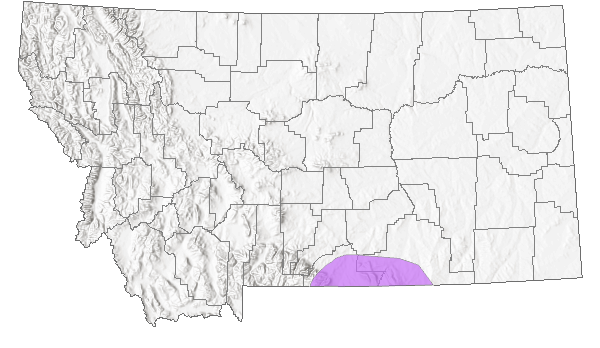
 Native
Native
Range Comments
In Montana, Dwarf Mentzelia is only known from Big Horn and Carbon Counties.
The name of Mentzelia pumila has been variously applied in regional floras and other taxonomic treatments of Mentzelia (Hufford, Schenk, and Brokaw in Flora of North America 2016). The Mentzelia treatment in FNA follows the morphological concepts formulated by Hill (1975) and Holmgren (2005) which is consistent with the phylogenetic results by Schenk and Hufford (2011) (Hufford, Schenk, and Brokaw in FNA 2016). Therefore, as described in this profile, Mentzelia pumila occurs in the states of Wyoming, Colorado, Montana, and Utah (Lesica et al. 2012; Hufford, Schenk, and Brokaw in FNA 2016)
Observations in Montana Natural Heritage Program Database
Number of Observations: 86
(Click on the following maps and charts to see full sized version)
Map Help and Descriptions
Relative Density
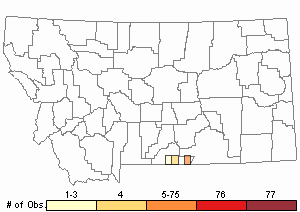
Recency
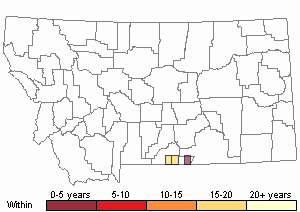

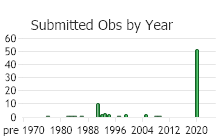
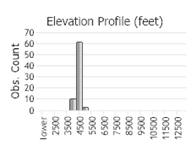 (Observations spanning multiple months or years are excluded from time charts)
(Observations spanning multiple months or years are excluded from time charts)
Habitat
In Montana, Dwarf Mentzelia grows in barren sandy soil of shrub-steppe and juniper woodlands in valleys and foothills of the Pryor Mountain Desert (Lesica et al. 2012).
Species in the genus Mentzelia in North America often grow on sparsely vegetated sites. They are found in disturbance-prone environments, such as arroyos, sand dunes, cliffs, or talus slopes. They are frequently associated with distinctive substrates, including gypsum, limestone, serpentine, or volcanic tuff. Some may be edaphically restricted (Hufford, Schenk, and Brokaw in FNA 2016).
National Vegetation Classification System Groups Associated with this Species
Forest and Woodland
Low Elevation - Xeric Forest and Woodland
Shrubland
Sagebrush Shrubland
Grassland
Lowland - Prairie Grassland
Sparse and Barren
Sparse and Barren
Ecology
ASSOCIATED SPECIESDwarf Mentzelia grows in sparsely vegetated shrub-steppe and Juniper woodlands. Associated species found in herbarium specimens (
www.pnwherbaria.org) include: Summer Milkvetch (
Astragalus hyalinus), Bent-flowered Milkvetch (
Astragalus vexilliflexus), Low Sagebrush (
Artemisia arbuscula), Black Sagebrush (
Artemisia nova), Big Sagebrush (
Artemisia tridentata), Shadscale (
Atriplex cofertifolia), Cock’s-comb Cat’s-eye (
Crypthantha celosioides), Rabbit Buckwheat (
Eriogonum brevicaule var.
canum), Fine-leaved Hymenopappus (
Hymenopappus filifolius), Basin Daisy (
Platyschkuhria integrifolia), Rough Mule’s Ears (
Wyethia scabra), Purple Three-awn Grass (
Aristida purpurea), Bluebunch Wheatgrass (
Elymus spicatus), and Indian Ricegrass (
Oryzopsis hymenoides). Concomitant woody species include Limber Pine (
Pinus flexilis) and Utah Juniper (
Juniperus osteosperma).
POLLINATORS The following animal species have been reported as pollinators of this plant species or its genus where their geographic ranges overlap:
Bombus centralis,
Bombus fervidus,
Bombus huntii, and
Bombus pensylvanicus (Thorp et al. 1983, Williams et al. 2014).
INSECT INTERACTIONSA study conducted on a related Dwarf Mentzelia in Arizona examined insect herbivory. Dwarf Mentzelia are densely covered with tiny hooked trichomes (small, branched hairs). The structures entrap and kill insects and as such likely deter insect herbivory. However, in one study the trichomes were found to incapacitate a
Convergent Lady Beetle (Hippodamia convergens) that preys upon an aphid enemy of the plant (Macrosiphum mentzeliae) (Eisner et al. 1998). The aphid is somehow undeterred by the hairs and able to move freely. The authors concluded that the adaptive benefit provided by the trichomes is offset by a cost in this case.
Reproductive Characteristics
Plants reproduce by seed.
FLOWERS
Flowers are inferior, with the ovary contained within the calyx tube. The calyx is 5-10 mm long with 5 narrow, pointed lobes. The petals and stamens are borne at the top of the calyx tube. Flowers appear to have 10 petals, but close inspection reveals 5 petals and 5 petal-like (petaloid) stamens, 9-15 mm in length. The petaloid stamens are flattened, spatulate in shape, yellow, and frequently have abortive anthers at their tips. Non-petaloid stamens are numerous. There is a continuum in morphology from petals through petaloid stamens to fertile stamens (Brown and Kaul 1981).
POLLINATION
At anthesis, flowers open during the day (diurnal) and again open in the late afternoon (crepuscular). Flowers open for several successive days.
In several Mentzelia species, pollen is released when the flower first opens each day, and loose pollen is held within the flower after closing, which provides an opportunity for self-pollination. However, in one greenhouse study, Mentzelia pumila set few or no seeds in the greenhouse in the absence of pollinators, suggesting it is an outcrosser (Brown and Kaul 1981).
FRUITS
The cylindrical seed capsules are 10-15 mm long. The seeds are flattened and narrowly winged.
Management
RESEARCH NATURAL AREAS and AREA OF CRITICAL ENVIRONMENTAL CONCERN PROGRAM
The Research Natural Area (RNA) program is a nationwide system created to protect a network of federally administered public lands established for the purpose of scientific research, maintaining biological diversity, and education (USFS 2014). The intent is to designate RNAs that represent the full array of North American ecosystems with their biological communities, habitats, natural phenomena, and geological and hydrological formations. These intact protected areas are managed to maintain their natural and primitive character with a minimum of human disturbance. Each RNA also serves as a baseline of ecological information that can be used to compare against other similar, yet managed ecological systems.
A type of RNA is the Area of Critical Environment Concern (ACEC). The ACEC program was established in the 1976 Federal Lands Policy and Management Act and is managed by the Bureau of Land Management (BLM) (Wikipedia Contributors 2020). Places designated as ACECs require special management to protect important historical, cultural, and scenic values, fish and wildlife, or other natural resources (BLM 2021). The BLM has extended the purpose of RNAs to that of preserving gene pools of typical and endangered plants and animals (BLM 2015; BLM 2021).
Pryor Foothill RNA/ACEC
This RNA-ACEC was established in the Approved Resource Management Plan by the MT/Dakotas BLM, Billings Field Office, recommended for approval by the MT/Dakotas BLM State Director in 2015, and is awaiting final approval by the U.S Congress (BLM 2015). The RNA-ACEC is approximately 2,606 acres in size. The management goals for the Pryor Foothills RNA/ACEC are to protect a large concentration of BLM's special status plant species and rare plant communities (unique vegetation) and to protect significant historic and cultural values in the Gyp Springs area. Large, intact populations of Dwarf Mentzelia live in the Pryor Foothill RNA-ACEC. A scattering of populations occur in vicinity of the Pryor Foothill RNA-ACEC. See Range Comments.
The area encompassing Gypsum Creek and Crooked Creek, which includes the present-day Pryor Foothill RNA/ACEC was recognized in 1991 as having the highest concentration of high-priority plant species' populations (Lesica and Achuff 1992). Surveys from the 1980's to 1990's found populations of eight rare species: Astragalus geyeri, Astragalus oreganus, Camissonia andina, Cleome lutea, Grayia spinosa, Leptodactylon caespitosum, Malacothrix torreyi, and Mentzelia pumila, of which remain as either Montana Species of Concern or Potential Species of Concern. The area's concentration of unique and diverse plant species partially results from diverse habitats, terrain that varies from highly dissected foothills with deep canyons to broad alluvial valleys, and soils derived from calcareous standstone, Chugwater sandstone, and limestone. In their 1992 report the authors recommended that this area would serve as the best choice for a single reserve in the Pryor Mountain Desert (Lesica and Achuff 1992).
GRAZING
Livestock grazing occurs in some of the areas were Dwarf Mentzelia is found. Palatability is unknown. Information on the interaction between Dwarf Mentzelia and grazing is needed.
Stewardship Responsibility
Threats or Limiting Factors
Across its range in Wyoming and Montana, current and potential long-term threats to Dwarf Mentzelia include (Lesica and Achuff 1992; Montana Native Plant Society 2021):
Gypsum Mining: Gypsum is a common mineral found in the Chugwater Formation. Gypsum claims have been made on public lands in vicinity of Dwarf Mentzelia. Potential negative impacts from mining activities include direct removal and trampling of plants. Potential indirect negative impacts from mining activities include disturbance to habitat from soil erosion, soil compaction, and colonization by invasive species. Soils in the Chugwater Formation are known to be very susceptible to erosion.
Invasive Species: The arid landscape in which Dwarf Mentzelia occurs is predominately in native, intact habitat. However, Cheatgrass (Bromus tectorum), African mustard (Malcolmia africans), and Halogeton (Halogeton glomeratus) are known to occur along roads near to some Dwarf Mentzelia occurrences. Halogeton outcompetes many native species by increasing the salinity of the soil (Sauer 1988) and has become locally common in the Pryor Mountain Desert region (Lesica and Achuff 1992). There is the potential for negative impacts based on the assumption that these exotics would be more competitive for soil water and nutrient resources, thus displacing native plants.
STATE THREAT SCORE REASON
Reported threats to Montana's populations of Dwarf Mentzelia are currently assigned unknown. Negative impacts to specific populations are not documented, and species likely benefits from some disturbance (MTNHP Threat Assessment 2021).
References
- Literature Cited AboveLegend:
 View Online Publication
View Online Publication BLM Billings Field Office. 2015. Approved Resource Management Plan Appendices. Billings, MT: U.S. Department of the Interior Bureau of Land Management. 438 p.
BLM Billings Field Office. 2015. Approved Resource Management Plan Appendices. Billings, MT: U.S. Department of the Interior Bureau of Land Management. 438 p. Brown, D. K. and R. B. Kaul. 1981. Floral structure and mechanism in Loasacae. American Jounal of Botany 68(3):361-372.
Brown, D. K. and R. B. Kaul. 1981. Floral structure and mechanism in Loasacae. American Jounal of Botany 68(3):361-372. Consortium of Pacific Northwest Herbaria (CPNWH) Specimen Database. No Date. Plant specimen data displayed on the PNW Herbaria portal. Website http://www.pnwherbaria.org.
Consortium of Pacific Northwest Herbaria (CPNWH) Specimen Database. No Date. Plant specimen data displayed on the PNW Herbaria portal. Website http://www.pnwherbaria.org. Eisner, T., M. Eisner, and E.R. Hoebeke. 1998. When defense backfires: detrimental effect of a plant's protective trichomes on an insect beneficial to the plant. Proc. Natl. Acad. Sci. USA 95:4410-4414.
Eisner, T., M. Eisner, and E.R. Hoebeke. 1998. When defense backfires: detrimental effect of a plant's protective trichomes on an insect beneficial to the plant. Proc. Natl. Acad. Sci. USA 95:4410-4414. Flora of North America Editorial Committee, eds. 2016. Flora of North America north of Mexico, Vol. 12. Magnoliophyta: Vitaceae to Garryaceae. Oxford University Press, Inc. New York.
Flora of North America Editorial Committee, eds. 2016. Flora of North America north of Mexico, Vol. 12. Magnoliophyta: Vitaceae to Garryaceae. Oxford University Press, Inc. New York. Hill, R.J. 1975. A biosystematic study of the genus Mentzelia (Loasaceae) in Wyoming and adjacent states. M.Sc. Thesis. Laramie, WY: University of Wyoming. 215 p.
Hill, R.J. 1975. A biosystematic study of the genus Mentzelia (Loasaceae) in Wyoming and adjacent states. M.Sc. Thesis. Laramie, WY: University of Wyoming. 215 p. Holmgren, N.H., P.K. Holmgren, and A. Cronquist. 2005. Intermountain flora. Volume 2, part B. Subclass Dilleniidae. The New York Botanical Garden Press. 488 pages.
Holmgren, N.H., P.K. Holmgren, and A. Cronquist. 2005. Intermountain flora. Volume 2, part B. Subclass Dilleniidae. The New York Botanical Garden Press. 488 pages. Lesica, P. and P.L. Achuff. 1992. Distribution of vascular plant species of special concern and limited distribution in the Pryor Mountain desert, Carbon County, Montana. Unpublished report to the Bureau of Land Management. Montana Natural Heritage Program, Helena, MT. 105 pp.
Lesica, P. and P.L. Achuff. 1992. Distribution of vascular plant species of special concern and limited distribution in the Pryor Mountain desert, Carbon County, Montana. Unpublished report to the Bureau of Land Management. Montana Natural Heritage Program, Helena, MT. 105 pp. Lesica, P., M.T. Lavin, and P.F. Stickney. 2012. Manual of Montana Vascular Plants. Fort Worth, TX: BRIT Press. viii + 771 p.
Lesica, P., M.T. Lavin, and P.F. Stickney. 2012. Manual of Montana Vascular Plants. Fort Worth, TX: BRIT Press. viii + 771 p. MTNHP Threat Assessment. 2021. State Threat Score Assignment and Assessment of Reported Threats from 2006 to 2021 for State-listed Vascular Plants. Botany Program, Montana Natural Heritage Program, Helena, Montana.
MTNHP Threat Assessment. 2021. State Threat Score Assignment and Assessment of Reported Threats from 2006 to 2021 for State-listed Vascular Plants. Botany Program, Montana Natural Heritage Program, Helena, Montana. Schenk, J.J. and L. Hufford. 2011. Phylogeny and taxonomy of Mentzelia section Bartonia (Loasaceae). Systematic Botany 36(3):711-720.
Schenk, J.J. and L. Hufford. 2011. Phylogeny and taxonomy of Mentzelia section Bartonia (Loasaceae). Systematic Botany 36(3):711-720. Thorp, R.W., D.S. Horning, and L.L. Dunning. 1983. Bumble bees and cuckoo bumble bees of California (Hymenoptera: Apidae). Bulletin of the California Insect Survey 23:1-79.
Thorp, R.W., D.S. Horning, and L.L. Dunning. 1983. Bumble bees and cuckoo bumble bees of California (Hymenoptera: Apidae). Bulletin of the California Insect Survey 23:1-79. USDA Forest Service. 2014. Research Natural Areas. Accessed 4 February 2021. https://www.nrs.fs.fed.us/rna/
USDA Forest Service. 2014. Research Natural Areas. Accessed 4 February 2021. https://www.nrs.fs.fed.us/rna/ USDI Bureau of Land Management. 2021. Areas of critical environmental concern. Accessed January 28, 2021. https://www.blm.gov/programs/planning-and-nepa/planning-101/special-planning-designations/acec
USDI Bureau of Land Management. 2021. Areas of critical environmental concern. Accessed January 28, 2021. https://www.blm.gov/programs/planning-and-nepa/planning-101/special-planning-designations/acec Wikipedia contributors. 2020. Area of critical environmental concern. Wikipedia, The Free Encyclopedia. Accessed 27 January 2021. https://en.wikipedia.org/w/index.php?title=Area_of_Critical_Environmental_Concern&oldid=994305208
Wikipedia contributors. 2020. Area of critical environmental concern. Wikipedia, The Free Encyclopedia. Accessed 27 January 2021. https://en.wikipedia.org/w/index.php?title=Area_of_Critical_Environmental_Concern&oldid=994305208 Williams, P., R. Thorp, L. Richardson, and S. Colla. 2014. Bumble Bees of North America. Princeton, NJ: Princeton University Press. 208 p.
Williams, P., R. Thorp, L. Richardson, and S. Colla. 2014. Bumble Bees of North America. Princeton, NJ: Princeton University Press. 208 p.
- Additional ReferencesLegend:
 View Online Publication
View Online Publication
Do you know of a citation we're missing? Keeler, K.H. 1981. Function of Mentzelia nuda (Loasaceae) postfloral nectaries in seed defense. American Journal of Botany 68(2):295-299.
Keeler, K.H. 1981. Function of Mentzelia nuda (Loasaceae) postfloral nectaries in seed defense. American Journal of Botany 68(2):295-299. Lesica, P., M.T. Lavin, and P.F. Stickney. 2022. Manual of Montana Vascular Plants, Second Edition. Fort Worth, TX: BRIT Press. viii + 779 p.
Lesica, P., M.T. Lavin, and P.F. Stickney. 2022. Manual of Montana Vascular Plants, Second Edition. Fort Worth, TX: BRIT Press. viii + 779 p. North Dakota Natural Heritage Program. 1993. 1991-1992 inventory of rare plant species in the Little Missouri National Grasslands. Unpublished report to the Custer National Forest. Bismarck, North Dakota. 72 pp.
North Dakota Natural Heritage Program. 1993. 1991-1992 inventory of rare plant species in the Little Missouri National Grasslands. Unpublished report to the Custer National Forest. Bismarck, North Dakota. 72 pp.
- Web Search Engines for Articles on "Dwarf mentzelia"





